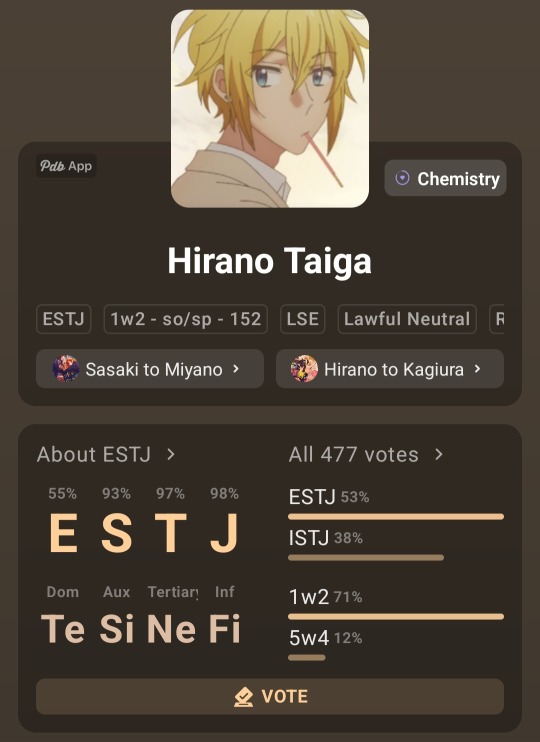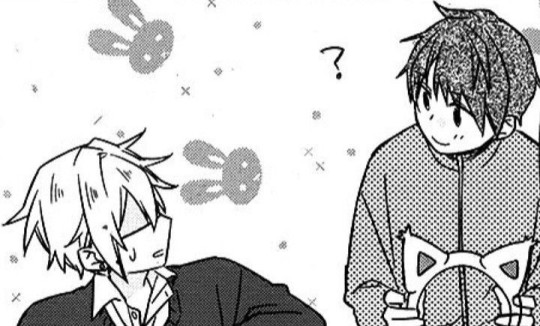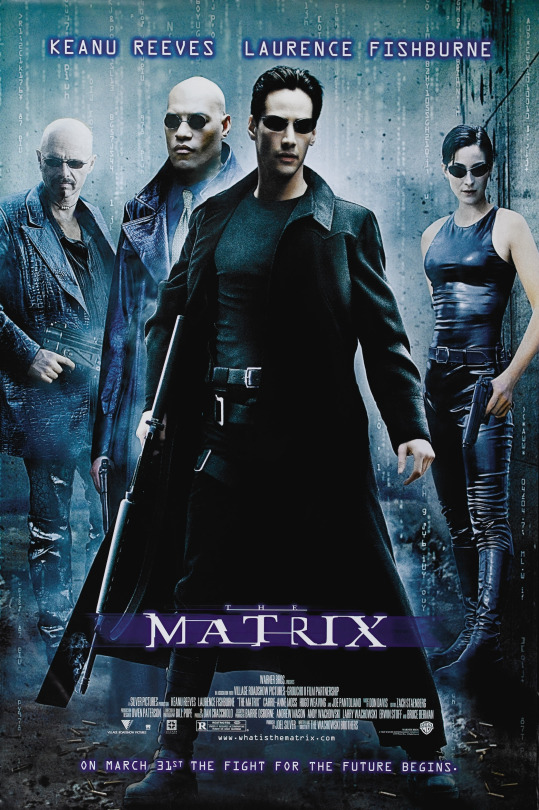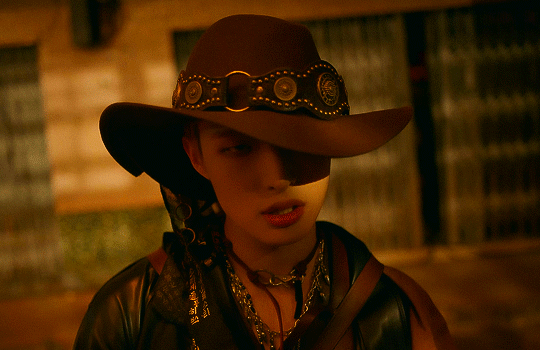#tert te
Explore tagged Tumblr posts
Text
The hard thing about typology is that eventually you reach a point where, despite knowing theory very well, you type purely off of habits/quirks/etc because they're easy to catch (when you know what you're looking for) and almost always right.
#typology#mbti#enneagram#god forbid anyone asks you the reason for your typing tho bc it like....#'yeah only 6s think they're 100% justified in passive aggressively giving someone the silent treatment so they get proof theyre cared for'#there are just key tells for things#micromanager? tert-te#cant have a conversation without telling stories? inxp/isxj#acts out to see people's reactions? se-dom#loves fault finding logic without giving a solution? ti-users#looks normal but has secret weirdass interests like true crime? isfjs#absolutely terrible at planning events? xxfjs#the thing is that each and every single one of these does have a reason#like a reason based upon cognitive functions/enneagram#but like...... people don't tend to believe you#and they want a deep dive into their psyche#not you being like 'well........ sx-blind 9w1s do tend to have the personality of a wet sock....'
21 notes
·
View notes
Text
never underestimate a tert te's ability to aggressively bulldoze anything that is about a 5 minutes worth of work and doesn't need any repetition it's just a one off, and could have been dealt with while behaving like a normal person too probably... lmfao. tho tbf soo many things that need convincing but COULDN'T have been dealt with if a normal person was trying their hand at it but is not done and done all in 2 minutes' work is exclusive tert Je territory.....
#'tert fe is really good at fe' was a genuine real thought ppl used to have and like all the high fe users who thought they were actually#tert fe aside. this is bcs being insane enough to reach your goals but it specifically has to be like. Not long term consistent situations.#is just the tert je brand#so. it makes sense that ppl thought that kinda......#tho kind of offensive how everyone was like 'tert fe is super good at manipulation' but nobody thought 'a tert te might effectively#disassemble the fucking yakuza if you gave them 5 minutes a knucle brass and (fi voice) A Reason™️'#://///////#t#001
1 note
·
View note
Text
MBTI Observations
I've seen some astrology blogs doing this kind of thing and it seemed fun, so off we go!
○ When they are attracted to you, ENTJs and ESTJs will treat you like royalty - they'll take on as many burdens for you as they can, no matter how insignificant they may seem. If they have anything to say about it, you'll never have to pay for anything, carry anything, or walk anywhere every again. They've already got you covered.
□ ESFJs and ENFJs are just as intense workaholics as ENTJs and ESTJs, but oftentimes don't get nearly as much recognition for it. They are very goal-oriented people who can sometimes fall into the trap of basing their worth on the value they assign to their accomplishments.
◇ Way more ISTPs suffer from social anxiety than most people think because their perception of ISTPs is clouded by the stereotype that they're all cool, calm, and collected badasses.
♡ While ESFPs are stereotyped as the partiers of the MBTI types (and they don't seem to fight that stereotype much either lmao), they are also resourceful problem-solvers when they effectively put their dom Se and tert Te together, and it often goes wildly unnoticed.
♤ ENTPs are so strongly stereotyped as funny, tricksters who take things too far sometimes (probably a combination of their dom Ne and tertiary Fe), but their tertiary Fe gets just as much use by their sweet side that isn't talked about very often. They make specific efforts to remember details about you for gift giving or engaging your interests to feel closer to you. They are jokesters because they can tend to love chaos, yes, but they also just want to make you laugh, or make you like them.
#mbti#mbti personalities#mbti types#mbti personality types#16 personalities#entj#estj#esfj#enfj#istp#esfp#entp#what do you guys think more observation posts?
22 notes
·
View notes
Note
to add to my most recent post about functions, how would you describe se and si because i get so tired of seeing “sports and adrenaline!!” “memory and nostalgia!!” for them in descriptions 😭🙏 and how would si-ne and fi-te interact as the aux and tert functions? i love your responses as always 🫶🫶
YESS I literally hate sensor/intuitive descriptions with burning passion...especially that one ni description I read online 😭...
I genuinely relate and understand more of functions through examples of them irl, so I sorted them this way if that is more helpful
se
very opportunistic: might see a sale at a store and jump on the offer (even do the math if high in ti). will also be quick to join in on tiktok, fashion, or internet trends and get easily excited and interested in them.
sees loopholes in rules/guidelines, finds ways around it
better at improvising situations: when cooking a recipe they will know what to do when missing an ingredient. will eyeball measurements they have to take. more likely to think of fun quick last minute plans if something goes wrong.
absurdism/stoicism: controlling what you can, embracing whatever happens, push and pull between finding meaning and being indifferent, makes meaning personal
mayyy be appearance focused (not always); jewelry, hair, makeup, FASHION...
si
can see distinctions easily: what someone sees as a forest, the si will see as spruces, pines, maples, etc. might also say, "__ is NOT the same as ___." is aware of grammar more quickly than others (not because they're focused on it, they do it with ease).
focused on mistakes: (might be forgiving if high in fe, but more like "forgive but don't forget.). BUT also remembers mistakes made by self as in hopes to not repeat them in the future. could also make them perfectionistic.
"oh, this reminds me of ___!!": gets excited when they learn a new word, and later see it used in a tiktok ;p
skeptical of things: doesn't trust ads they see immediately, does research on a product before buying, thinks critically about social media (and celebrity culture in general), doesn't trust if something is 'too good to be true'
focused on meaning: unlike se which is more indifferent, the istj is more likely to ask what the point of doing something before they do it. doesn't necessarily like things that are pointless (combined with unenjoyable). **DOESN't mean they don't have hobbies based on enjoyment, tbh most istj's find meaning through their own emotions as well
46 notes
·
View notes
Text
hirano typology analysis <3

okay, everyone! let's start off from this page first thing first.

as you can see he's typed estj 1w2 but let's go further in this:
estjs are te-fi si-ne axis based which means his te and his si need fi and ne to function (this axis is applied for ti-fe se-ni as well and goes both ways).
(for anyone who doesn't know how this works: cognitive function in a stack of 8 make a type AND it's shadow type (your "opposite" type) as you can see in the screenshot up there functions are set this way: introvert > extr. > intr > extr. OR extr. > intr. > extr. > intr.)
let's start with his dom-aux stack
honestly, i believe he's an estj as well so im going to stick with this typing.
his dominant function is Te, i think this guy has an unbearable amount of Te here 😭
up to now I've noticed he is:
- rational
- more in his head than his heart
- pragmatic
- focused on efficiency
- very responsible
- direct (says what he thinks in your face even if it might hurt you (for ex. like when he rejected kagi for the first time)
as for his Si, which is high as well, this is what I've noticed:
- respects traditions (doesn't mean he supports them but he has nothing against them)
- sense of duty and responsibility
- he needs structure and order
- he's loyal
- resistant to major changes
- stubborn
- tidy
actually about his dominant function (between Te and Si) i have something to say about his Fi in the tert-inf stack. i think he uses much more Fi than Ne so I'd move it to tert. position and put Ne in inf. that'd make him an istj tho. in the latest chapter we can see how he thinks it's "right" not to stop Kagi from moving on but it's not an action of pure morality since sensei's shown us his whole reasonment. we can see that it's more of a "rational morality" which in a in a typology aspect is clearly Te and Fi working together. Still, i think both an istj and estj typing are correct since there's only a difference in the functions positions (estj: Te-Si-Ne-Fi istj: Si-Te-Fi-Ne).
okay now comes my fav part of typology!
enneagram, tritype and instinctual variants!
im gonna note them here so I don't have to scroll up over and over again.
enneagram: 1w2
tritype: 152
instinctual variants: so/sp
alright, so. I'd make some changes here.
first thing, his enneagram. i think e1 is correct for him since e1 is a perfectionist who thinks they have some kind of mission, they're usually systematic and responsible (in his case his self-given mission could be helping kagi with his studies for ex.) while for his w2, i honestly don't know because e2s help others out of a personal gain (to feel better about themselves) which I don't think is hirano's case because he genuinely helps others even if he doesn't get anything in return. he could be a 1w9 in my opinion. type 9s look for harmony and peace and fear having their harmony shaken/broken which could be related to his change avoidance? i think it's surely better than 1w2 (since type 2s are subconsciously selfish and he isn't selfish at all).
tritype: i think it's correct, although I wouldn't type him an e5 since he's not shown us he likes to collect knowledge "just because"
instinctual variants: I don't think so/sp is accurate, he's probably an sx/so. from my point of view it's like he values his close relationships more, by this i mean it's like he's completely comfortable with only one person (which is kagi) and I wouldn't change the social typing
we reached the end of my analysis!
it's probably confusing since my thought process is very messy to begin with, I'm sorry if it seems like that 😭
cyaa <3

#hirano taiga#hirano to kagiura#kagihira#kagiura akira#sasaki to miyano#hirano and kagiura#hirakagi#typology#mbti types#mbti personalities#enneagram#tritype
25 notes
·
View notes
Text
ATEEZ Wooyoung MBTI Analysis
- ESFP -
An in-depth analysis of an idol's MBTI type. Based on my opinion and observations, may change later. Not an expert.

ESFP (Se - Fi - Te - Ni)
Dom: Se (Extroverted Sensing)
A perceiving function that uses our 5 senses to process the external world.
Wooyoung is always aware of the present moment, quick to react and to take action. He also pays attention to physical things such as aesthetics, the visuals of the performance, the way he looks, etc physical appearances matter a lot to him.
He enjoys photography and videography, which are pretty good activities for Se - it allows him to use his senses to make visually stimulating images and videos. Physically engaging activities seem like the best way to energize him e.g cooking and riding a bike. Cooking is great for his Se as it engages with all his senses - all the movement in cooking, tasting the foods, the aromas, watching the food cook, plating, maybe he enjoys hearing the sounds of food cooking as well and/or the way kitchen tools slightly hit each other (e.g knife on a cutting board).
This moment especially was an incredibly Se dom moment. Comparing it to Si user Jongho (Si has to step back and assess first), being the Se dom he is, Woo just went for it.
Aux: Fi (Introverted Feeling)
A judging function that uses one's own values and belief to compare and make choices
As Fi wants to be authentic, that is what Wooyoung always strives for - he always wants to express himself well, to be real. He wants people to like him for him. He returns the same gesture with others - he wants to know the real version of others. Wooyoung tries not to make assumptions at first meet since he knows he will not learn everything just from one encounter. He seems very empathetic.
Tert: Te (Extroverted Thinking)
A judging function that uses established facts and systems to make objective, working decisions.
He's quite goal oriented and takes time to plan to achieve these goals, even if it's not the most detailed. Either way, he knows how to get what he wants and works hard to reach his achievements.
Wooyoung lays down the rules as well - Te can be by the book, which Wooyoung can be sometimes. E.g when he was explaining how he found it rude when juniors would not put in the effort to correctly bow down to him and other senior artists. Wooyoung has a strong belief in being humble and kind (Fi) and wants to implement this in everyone.
Inf: Ni (Introverted Intuition)
A perceiving function that uses one's own personal insights and ideas
In his episode of "Fill in the Blank" series, Wooyoung said he wanted to use dance to convey deeper messages and emotions for others. He wants to be a sense of comfort, the light in other's darkness. He has always wanted to make an impact on others from a young age, especially considering how much he values relationships.
___
Why is he not an xSFJ or ISTJ
Both types use Si - Ne, which I do not see in Wooyoung at all...xSFJ's Fe is understandable, but Wooyoung is sometimes a bit too straightforward and honest to be using Fe in his main stack though lol.
And ISTJ just does not make sense in general for him.
___
Other analysis:
Enneagram | Birth Chart
___
Kpop typology list
#wooyoung#ateez wooyoung#ateez mbti#mbti#jung wooyoung#kpop#typology#kpop mbti#cognitive functions#myers briggs type indicator#ateez#myers briggs#esfp#esfp mbti#extroverted sensing#introverted feeling#extroverted thinking#introverted intuition#mbti analysis
40 notes
·
View notes
Text
Mistyping on MBTI
Introduction
The purpose of this post is to understand what are mistyping and how they happen. I’ll explain some of the patterns ive noticed when it comes to some of the mistypings as well as some of examples ive I personally disagree with. Please dont take any of this as a personal insult if any of these examples I give are things you've done in the past or the typings I disagree with are your own.
Case #1Misunderstanding Functions
-What I refer to by the misunderstanding of functions I mean it's the general purpose of the function and how does this function work and perceive reality. I understand that functions can be complicated and Carl Jung’s definition of Ni can be convoluted and confusing (sometimes just plain vague) however I do think that typing people/characters needs at least allot of backing up with your knowledge of functions. Usually the misunderstanding I see with each functions comes out in these ways.
Si- Memories/Any form of previously obtained knowledge
Se-Impulsiveness and Aggression
Fi-Sensitivy and Emotionality
Fe-Caring
Ti- Thinking in any capacity
Te-Rudeness
Ne- Quirks and Quips
Ni- just knowing stuff

Ex-Sasuke Uchiha (ISFP)- Sasuke is often typed as an INTJ due to his preference for Ni-Fi HOWEVER when it comes to how he perceives reality and his way to deal with conflict its pretty clear he is an Fi dom. There is this misconception of Fi=Sensitivity and Emotionality. However this couldn't be farther from the truth. Fi is simply preferring your Core Values and desire over the other. His goal was always Fi related NOT Ni related.
Case#3 Simplification of Functions
Following the last case this is usually the more common one I see when it comes to mistyping usually people will flatten functions or just straight up default to god awful stereotypes of each type when it comes to typing them. You'll often see people “Trope Type” certain charcaters. Most of their arguments revolve around the aesthetic of the character and then their functions. Which is why those peoples typing will usually look like this.
ESXJ-Mean Girl and stuck up
ISXJ-Boring ones
ESXP-Immature,Dumb or straight up substance abuse
ISXP-Edgy
XNTP-Quips and Quirks but always the smartest
XNFJ-Kind Humanitarian
XNFP-Sentimental mess
XNTJ-Villain

Ex-Naruto Uzumaki (EXFP)I know I previously typed him as an ENFP however I've been thinking of the relation of his Se-Ni throughout the show and I might change my typing. However thus far every single Se dom argument I read for Naruto reads like this “ Well he is immature” “he is impulsive and reckless” “ can't be an Ne dom because Intuitive=smart and Sensor=Dumb” sometimes they don't say this word for word but their arguments boil down to this. And I find it quite frustrating cuz those same people look at you straight in the eye and say that you're intuitive bias, even tho they are the ones defaulting to stereotypes.
Case #4 Positioning of Functions
Character development in MBTI is more complex than character development in Enneagram. Depending on the movie/tv show the character might either develop their inferior function or their tert function. Which is why understanding the position and model you are using for MBTI and be consistent using it. The position of function is important because they are what defined the person and how they approach data management. Also certain characters might have preference for their tert function rather than their aux functions. Some Characters just use their stack in a very balanced way.

Ex- Sokka (ESTJ)- He is often typed as an ENTP due to his exaggerated use of Ne in the later seasons. To me at least he is an ESTJ with a preference for TeNe. Sokka never really uses NeTi in the first book. His priority came in form of TeSi (Organizing the environment with a solid metric and detailed positioning of others). His development came in the form of his Ne not Fi. To the point he ends of sticking to it in Book 2 and Book 3.
Case #4 Character Traits=/=Cognitive Preferences/Perception
Often people conflate how a character/person acts instead of how they think and proceed with conflict. MBTI isnt really a personality theory but rather and understanding of your cognitive process and preference. It's based on how you perceive reality and how you make decisions based on your dominant function. If anything enneagram would be closer to an actual personality test.

Ex- Amy March (ESFP)- I took such a long time to come to this typing because similarly to Naruto people only talked about how she was an annoying immature child. However her monologue points to her stresses and how she must stick to her SeTe rather than SeFi due to how the environment is working and suppressing women in that era.
Case #5 Just making things up
This is the most common one I see when people type characters, they usually just make things up. Sometimes there isn't any contextual evidence on what they are talking about and will mostly differ to broad and vague statements that hold no wait or aren't represented in the narrative. Sometimes they'll just take things out of context and will just go with them and end up convincing people even if their argument is 95% fabricated stuff and the 5% is misunderstanding on their part.

Ex-Ada Wong (IXTJ) Ada Wong’s Ti is non existent and no one online has ever written an argument where I there is enough evidence on what they are saying. Ada isnt a person who is interested in analytical process and internal understanding. Even character development comes from XiFi not Fe. Sorry but liking Leon but not really isnt a good argument for low Fe. Her development isnt about understanding the emotional state of the other or in relation to the other but rather the self. Even OG Resident Evil its stated that she struggles with her own values and emotional state . It's almost as if their argument hinges on ISTP=Spy characters.
Case #6 Misogyny (yeah...we are going there).
Often in typology you'll notice a dichotomy between Female characters vs Male characters. You'll notice that female characters are twice as likely to get typed as Feelers even when they dont show much usage of any feeling function. Often the arguments I see its in reference to either showing the character struggling emotionally or reacting in some way to something bad happening in their life. But when male characters such as Homelander and Patrick Bateman who have multiple emotional outburst in their runs but most people type them as Te doms. While Female characters that have emotional outburst such as Asuka and Jennifer Harding (Both Te doms) both get typed as ESFP because=SeFi=angry and emotional. It often happens in cases such as Bakugo who gets typed as an ESTP but if a female character does the same thing she gets typed as an ESFP. Im not calling you a misygonist if you typed any of this characters like this I just think that you should reconsider your typology process.
Ex-There are allot of these so I just gonna point to a few

Alice Liddle (INTP) - Being typed as an INFP but very clear her struggle is between Ti-Si and understanding her Fe.

Nancy Wheeler (ESTJ)- Being nice=/=Fe she has always preferred TeSi (organizing and structuring things in step by step processes) Over using Fe.

Madison Montgomery (ESTP)- Her character is pure SeTi and her struggle with her Fe is shown in both S3 and S8.

Yenneffer (INTJ)- NiFi reaching the ideal self is her goal also her Te is very on your face.
Part 2 will focus on the enneagram
Please dont take any of this as an attack its an analysis on things ive seen and read if you are gonna disagree please be civil.
#mbti#zodiac#zodic signs#personality types#16 personalities#ennegram#mbti personality types#enneagram#estj#enfj#intj characters#isfp characters#mbti estj#estj characters#enfp#enfp characters#naruto#naruto uzumaki#sasuke uchiha#typology#mbti stuff#ada wong#resident evil#alice in wonderland#intp#estp personality#madison montgomery#yennefer#nancy wheeler#stranger things
116 notes
·
View notes
Text
Anon wrote: hello! so, for the longest while, i was convinced that i was an infp. but, very recently, i realised that the struggles that i was going through, the problems that were coming up repeatedly, seemed to be more indicative of ne-te loop. i didn't actually get very far with the function development guide once I'd determined myself to be an infp btw. life kinda got in the way.
anyway, this realisation prompted me to delve back into your type theory guide. for the past week or so, I've been going through it in detail with a clear mind, considering every single type as a possibility and rejecting them one by one according to the evidence I'm typing up. I'm still about midway through the inf functions in the proper procedure that I'm following, but i've skimmed that entire post and others, because there's a couple of questions that's been bugging me throughout.
I've more or less narrowed myself down to an xnfp, although like i said, I'm still open to considering other types as well. what I'm mostly stuck with is the following:
1. how is an enfp's ne-te loop going to look in contrast to an infp's te grip?
2. how is an infp's fi-si loop going to look in contrast to an enfp's si grip?
i understand that, of course, every person is a unique example of their type. but I've been stuck with these two points, since i couldn't find anything on your blog related to how a specific tert function's loop looks in tandem with the type's corresponding dom function. like, i know what te-loop looks like, but i don't know how it would work with ne dom. i suspect where i might have gone wrong with typing myself (if i was mistaken, like i said, i am still going through the theory guide intensively), was misidentifying si grip as fi-si loop.
if you do have any past posts that I've missed, I'd appreciate you redirecting me to them. and i hope my doubt is clear, and that you'll be able to help me out. thank you!
-----------------------
As far as I can tell, there are several issues to address:
1) Overemphasis on how functions "look": This usually means you're too focused on outward behavior (superficial) and not really understanding how functions operate inside the mind (fundamentals). Until you are able to draw a proper distinction between cognition and behavior (which is the first major principle that I teach in the Function Theory guide), your focus will likely be misplaced on the what and then missing the why. Asking "what does my Te look like?" won't get you as far as asking "WHY do I use Te in this way?" Basically, you're not going deep enough.
2) Not accounting for Function Dynamics: Newbies often get stuck on viewing functions in isolation, which exacerbates problem #1 above. Once your learning becomes more advanced, you'll understand that functions are dynamic and intertwined. For instance, tertiary loop and inferior grip are very different because the function interactions that produce them are very different:
- Tertiary loop arises due to a unique relationship to i) dominant dysfunction, specifically dominant immaturity, and ii) auxiliary underdevelopment, specifically auxiliary resistance. Thus, evidence of tertiary loop must also include evidence of those two issues, which I have already included in the guide under the dominant and auxiliary function sections. These three parts must fit together properly.
- Inferior grip arises due to dominant dysfunction, specifically dominant extremes that create a troubling imbalance. One reason people find themselves in dominant extremes is because they're trying to force the function to work in unsuitable ways/situations, which causes escalating problems with stress, to the point of not being able to cope and adapt well. Thus, evidence of inferior grip must include i) evidence of dominant extremes, and ii) eventual loss of healthy dominant functioning, information which is already included in the inferior function section of the guide.
3) Not accounting for Type Dynamics: Type dynamics refers to the theory of the functional stack, of how the whole is more than just the sum of its parts. Each of the four functional stack positions serves a unique and specific purpose in your psychology with regard to what the ego needs and wants, which is briefly explained in the beginning of each stack position section, as well as the type dynamics section of the Type Dev guide.
For example, the proper purpose of the tertiary function is to complement and temper the auxiliary function. However, tertiary loop means that this healthy dynamic is altered and the tertiary function is being misused for a different and more nefarious purpose of propping up a failing dominant function.
This goes back to point #1 above of not grasping the "WHY" - what is the purpose of each function in the mind? It's very important to ask yourself WHY you are using the function in that particular way, in relation to the other functions. To what end or to what purpose is the behavior meant to serve?
.
It looks like all the information you need is already included in the study guides, so perhaps you have only been picking out some superficial points about the "look" of functions and ignoring the more important theoretical concepts that would help you understand WHY functions look a particular way. The problem with not reading the guide all the way through to full understanding before you start doing the hard work of analyzing yourself is that you won't see the bigger picture of how all the parts are meant to fit together.
Psychology is complicated, so function theory isn't exactly easy to learn. There are many levels of comprehension and you're still at the beginner level. It's certainly not a crime to be a beginner, since we all have to start somewhere. However, don't sabotage yourself with poor learning methods such as disorderly/unfocused reading, taking shortcuts, or thinking that the "gist" equals complete knowledge - these are common learning obstacles for NPs.
9 notes
·
View notes
Text
why 8th function should be much better than 7th
when i say 8th i mean si for intj and when i say 7th fe for intj.
what makes 7th function special? why it’s blindspot? why 8th function is not also very blindspotish? if this is about repression, how come intj’s te repress fe HARDER than their ni repressing si? is that even the case?
when this question asked, people will tell you “well, ni and si are both introverted perceiving functions so si is not alien to intj”.
funny thing is this line of logic can be applied to intj’s te too. “te and fe are both extraverted judging functions, they are more practical and general and heuristic”. how come this te auxiliary type, who understand the value of being practical and blabla, is not practical at all when it comes to fe?
BECAUSE there are layers to repression mechanic. yes, te of intj represses fe but fi of intj represses it much harder!
now you will say, “but intj’s se should also repress si much harder so equation doesn’t change, there are layers there too.” there’s one more layer though: all introverts and their introverted functions are bolder than their extraverted ones. so intjs fi is bold, edgy, individualistic, opinionated WHILE their se is cautious and cooperative and accepting.
naturally therefore a cautious and cooperative se won’t repress si hard but intj’s fi will destroy fe with every action.
there’s also producing/accepting dichotomy in socionics. for all types, not just intj, blindspots aka polr accepts informations which btw the word accepting absolutely doesn’t mean “yielding” to information. then tertiary function for all types is a producing function.
so intj receives/accepts with their fe: “oh you want me to behave, you want me to be politically correct, i see!” then with their tert fi they go: “fuuuck your political correctness, here are MY values, here are MY thoughts”
meanwhile, all types and their inferior function accepts information while their 8th function produces. so when intj realizes an se thing must be done, they produce an si solution for it. so they take their time, acclimate to the situation, “feel things out”, follow a gradual path as opposed to some entj or estp ka-booming. obviously though, their si still gonna be weak. they might take too long to prepare or they can miscalculate the complexity of si preperation. nevertheless, they are trying with si while they don’t, at all, with fe, due to the fi dominance over it.
#intj#mbti#socionics#personality types#jungian typology#producing accepting dichotomy#bold cautious dichotomy#layers of repression#blindspot#tertiary function
2 notes
·
View notes
Text

Otto (pre-orb) and Cider circa the late 80s/early 90s? I haven't put together a timeline. Someone get this man a hairbrush please. Mm I am annoyed because Otto is my favorite character (along with Cider) and I cannot draw him in orb form to save my life. Why is he so difficult to draw. This whole concept was funnier in my head.. oh well
Transcriptions below the cut. Also I must infodump about Chipspeech characters' MBTI so that too.
Otto: This human form is limiting Cider: Otto please calm tf down
Okay it's MBTI time. I go from fandom to fandom finding the weird scientist characters and then I observe them with my little autistic eyeballs. The fact that both Cider (ESTJ) and Otto (INTJ) are high Te makes me (also high Te) very happi because usually scientist characters end up being high Ti. Cider especially because I often find xSTJ science-related characters to be unlikeable and he is decidedly not. I am an ESTJ-adjacent creature and I must scream
My opinions on Chipspeech characters' types: Cider: ESTJ (TeSiNeFi) Otto: INTJ (NiTeFiSe) Dandy: ESTP (SeTiFeNi) Dee: ISFJ (SiFeTiNe) Vosim: xxFJ (high Fe) Bert: ExTP (aux Ti, tert Fe) Rotten: ENFJ (FeNiSeTi) Spencer: ESFP (SeFiTeNi) Lady Parsec: ENTJ (TeNiSeFi) Sam: idk man, probably on the Ni-Se axis Pedro: ESFP (SeFiTeNi) Voder: ISTJ? Maybe? Definitely somewhere on Te-Fi and I think Si-Ne but I'm open to being wrong. Terminal: ESTJ? He's said his personality is low priority in his system and it's not always running, so idk if he's even really typeable.
One day I might make a post with an in-depth analysis of each character's cognitive functions because every fandom needs a typology nerd that everyone else politely ignores but that'll have to wait until I can actually figure out everyone's stacks in full.
Also obligatory PSA: if you want to take an MBTI test that has a pretty good likelihood of typing you correctly, the best one out there imo is Mistype Investigator, or Jung's Igloo if you want results that are easier to read. 16Personalities is not actually MBTI (Neris is closer to Big 5), and Sakinorva and Keys2Cognition both tend to overestimate Ne so probably avoid them. MBTI is not real science but it's fun to apply to fictional characters, just don't take it too seriously. I feel the need to say all of this because I've had problems in the past where this information would have been useful to have, maybe it'll help someone else. Idk
#Otto's kind of a menace but I respect that about him#Please pay no mind to Cider's box of miscellaneous geometric shapes#I know there are at least three other people out there who like Chipspeech and MBTI because of PDB votes.. are they on Tumblr......#also who put that ENTP vote on Cider's profile >:(#anyways can I just say that Otto is a comedically stereotypical INTJ to the point that it's honestly extremely funny to me#he'd be right at home on r/INTJ (hellhole do not go there) down to the heavy usage of low Fi which he insists he does not have at all#“I have no feelings” no what you have is blindspot Fe. I can see your Fi and I would like to study it#sorry Otto for comparing you to r/INTJ but it had to be said#chipspeech#otto mozer#cidertalk'84#cidertalk84#posts by the bug
18 notes
·
View notes
Text
Sousou no Frieren typology
Frieren - INTP 5w6 sp/so Double Bird
The conflict between her and Serie is basically Ti-Te clash. Her way of approaching a magic is also very typical of Ti-user. To her, magic is about studying and discovery. A Te-user wouldn't see it that way. Look at Serie and Fern, magic is fun and they both love magic. But they still focus more on utility than just the understanding.
The story is about Frieren developing Fe-inferior. Learning to connect to people, to put herself in other people's shoes, to uphold values of people who she holds dear (Himmel, Hero's Party and Fern). She became more emotionally open as the series progress (look at her expression in ep 1 and ep 28, it's night and day).
Fern - ISTJ 1w9 sp/so Lion-Bird
An adorable prude who's very pragmatic and efficient. Her fighting style sums up strong Te-user approaches to fighting. Using the most effective mean to fight. It doesn't look fancy but it's pure brutal efficiency.
I do practice martial arts and my approach is similar to Fern. She only uses 2 spells - barrier and Zoltraak (basic offensive magic). It's similar to my approach to martial arts. Just master the basic and knock people out fast. You don't need anything fancy, really. The basic is usually more than enough, if you master it.
Stark - ESFP 6w7 so/sp Badger-Lion
Adorable labrador. Nothing to elaborate, he is the easiest to type.
Himmel - ENFJ 2w3 so/sp Double Badger
This is the man. A role model for me.
Eisen - ISTP 6w5 sp/so Double Badger
He is a little hard to type, but we see consistently throughout the series and manga that he is a head type. Fear is his driving force and he is an attachment type, so 6-core.
Heiter - ENTP 7w6 so/sp Lion-Snake
Sly old fox. He grows up becoming a dependable and upright old man (with a touch of playfulness) showing healthy line of 7-1. But he never lost his playfulness and inner brat.
Serie - ENTJ 8w9 sp/so Lion-Bird
Serie is the epitome of Te-dom. Her mindset is pure utilitarian. Magic is a tool for killing. She loves magic and advancement in magic study is all she wants. However, unlike Frieren, it's not just about understanding but about application. She is pretty hands-off but when need arises, she will get her hands dirty (and loves doing it) showing grittiness of Se-tert and 8. She is pretty withdrawn though owing to her 9-wing.
Flamme - INFJ 6w7 so/sp
Flamme is all about Ni. She knows exactly when and how Frieren will fuck up and plans ahead ... for millenia. She understands Frieren well enough to see where she will go. Flamme shows good usage of balanced Fe-Ti. Fe-Ti are tools to her (unlike Himmel), so she can detach herself more. She understands the culture and mindset of demons and exploits it hard (Fe-Ti working together). Her method is underhanded but pragmatic. She is an obvious head type. Her reasoning and tactics came from the head (analysis) rather than the gut (instinct).
Denken - ESTJ 3w2 sp/so
Denken is a good example of healthy and mature ESTJ and 3w2. He is very pragmatic and strategic but not callous. He is aware of his own standing and isn't afraid to assert himself but also cooperative and levelheaded. We must remember that Denken is an old man at this point. He is an example of a 3w2 integrating to incorporate good aspect of 6w5 (cooperation, genuineness, tactical thinking and a sense of duty).
He used to be stereotypical ESTJ 3 - cutthroat, ambitious to a fault and cold. But the death of his wife and the situation of his hometown shapes him into a wise old man.
Ubel - ESTP 7w8 sp/so
Why do people think she is Ne-dom. She is all about sensory experience in the here and now. That's Se-dom.
3 notes
·
View notes
Text
i know i said this but honestly i also think this:)) just not at soc blinds necessarily. and not after being mean to someone but rather like why do u care that i am possibly somewhat rude or dismissive and why do u refuse to talk to me later if talking to me later is for necessity or efficiency purposes. like how is this personal to you if i wasn't bad but rude or annoying or wtv. we literally need to be done with this can you get your ass over here ffs
i love soc doms w all my heart until they do that weird thing where they go 'umm. why do you even CARE what i think??? you should continue talking to me even after i insult you and behave aggressively if you 'didn't care' but clearly you Do.' to a soc blind who doesn't wanna talk to the soc dom bcs they were mean to them. bcs they misinpreted the situation. a bit. and thought the soc blind was being aggressive when they were just kinda Silently Vibing or at most being irritating but still 'expected to be talked to' later on
#tert te woes... i WILL be aggressive and extra ass fuck and you WILL talk to me later if it is for my te ass purposes.#bfjdjdwinfsjfhhh#t
2 notes
·
View notes
Note
Hooooy! MBTI types as movies? :D
HELLO, and thanks for waiting so long for me to do this 😭 I literally typed all the movies like a million years ago and just haven't had any time to put together the little analysis blurbs but I'M HERE NOW SO LETS DO IT.
Also sidenote: I am notriously terrible for remembering the full plots of movies (and don't watch a ton of movie in general) so if anything seems off in these analyses (aside from the fact that I tried not to go FULL STEREOTYPE), I would bet it is more of a problem with remembering the movie than it is understanding MBTI, but hey, what do I know lmao
MBTI Types as Movies
INTP: The Matrix

The GOATed movie for the GOATed type, what can I say. LMAO, just jokes, just jokes on both accounts. I mean, they're both great, but you know, I mean no offense. Still, I think this fits well because you spend so much of the movie how things work in the Matrix because the rules of reality start getting wonkier the more they investigate. Ti loves figuring things out and Ne is all about things being new and/or different, so it was an easy pick. Maybe a bit stereotypical, but hey, at least it wasn't Lord of the Rings or Star Wars (also great movies, but come on, it's been said a million times, we gotta shake it up a LITTLE).
ENTP: Jurassic Park

Watch the scene where Dr. Ian Malcom tells everyone "you were so preoccupied with whether or not you could that you didn't stop to think if you should" and TELL me this isn't an ENTP movie lmao. Jurassic park is ALL about how new and interesting of a possibility modern-day dinosaurs could be, and they had the Ti and science to back up their ambitions. And also the tert Fe to decide to make it a theme park I guess? Lmao, it's like, okay, sure, kinda weird, but I GUESS people will like it.
INFP: Scott Pilgrim vs The World

The movie is very Fi portraying Scott's life because you can feel just how everything is so personalized and tailored to his lifestyle and preferences that even things like his band feel like an extension of himself. The same goes for the other characters in the band too; even minor characters have so much individuality with such little screentime, which appears very Fi-dom to me. And also just like, cartoon + anime logic to fight Ramona's evil ex's is such an Ne premise because of how different and sometime random it is - I love it. Sidenote: Scott Pilgrim Takes Off on Netflix is a super good miniseries!
ENFP: Inside Out

A fun and zaney way of expressing your own personified emotions that all interact with each other and are interwoven with your real life struggles and choices? Can that get any more ENFP if it tried? Not to mention that people have taken to creating their OWN versions of their primary emotions, too. Explain to me how Bing Bong could ever exist without a massive super dose of Ne, lmao.
INTJ: Dune

A futuristic sci-fi universe with complex and realistic political unrest, economic corruption, and ecological issues to demonstrate examples of the abuse of power all wrapped up in one big collection is like the epitome of an INTJ and dominant Ni to me. As silly as this might sound, I really did NOT follow this movie super well, even though it SOUNDS like it should be up my alley as an INTP, and that in part lead me to think it might be more of an INTJ movie. It's got a lot of the same ingredients, but you can tell it's just built different because of the massive world-building.
ENTJ: The Truman Show

I would say the premise of staging Truman's entire life with the expectation that it will persist all the way into his old age as a way of capitalizing on it for profit and TV show ratings is a pretty Dom-Te, Aux-Ni, ENTJ kind of thing to do. A BAD ENTJ thing to do, but ENTJ nonetheless. Everything that happened to Truman had an intended purpose, which was to keep audience engagement with the show. I COULD see an argument made for this being an ENFJ thing, but I decided ENTJ because at the end of the day, they cared more about and prioritized the boons to be gained from continuing the show, not necessarily the emotional reactions of Truman, themselves.
INFJ: Eternal Sunshine of the Spotless Mind

Probably my favorite movie of all time (if you couldn't tell, I really like Jim Carrey) has to go to INFJ. This movie really takes you so far into his head, and really captures what it is like to be doing that dom-Ni thing of looking for and assigning symbolic meaning to things (often times other people's thoughts and actions), especially in such a way that can be dangerous, and seems to be a major cause of both main characters' debilitating depession and self-confidece issues. Not to say all INFJs are like that, of course, but a lot of the themes that come up in this movie are great examples of just how wrong things can go with unhealthy Ni-Fe.
ENFJ: Gone Girl

Similar to ENTJ, Gone Girl has some very potent ENFJ vibes, again, also BAD ENFJ vibes, but still ENFJ vibes. The main antagonist really shows off all of the classic techniques for emotional manipulation via Fe, and the seamlessness of it all as she consistently remains one step ahead of the protagonist the entire time really demonstrates the forthought that can come with Ni. Sometimes she is so far ahead of the protagonist, he even has a hard time decifering what she is even planning to do next, or the intended outcome. ENFJs being Fe-doms lends themselve to still be outcome-driven like ENTJs, but here, the intended outcomes are emotionally and socially colored.
ISTP: Good Will Hunting

The ISTP gets all the glory for being aloof, and dangerous to mess with, and that isn't NOT present in his movie, but what they DON'T get enough credit for is their capacity for an impressive intellect. ISTPs are Ti-doms just like INTPs, so it should follow that they have incredibly logical and curious minds that have an aptitude for understanding how things work - that's a big plot point for our protagonist who solves the infamously difficult equation on the chalkboard, only to find out that he isn't stuff academic like everyone EXPECTED him to be. Grounded by his Se, he even mocks students attending the university for spending so much money on their education, when he has learned just as much for free with his library card. Raw intellect with no fluff (and no fucks to give) is ISTP through-and-through.
ESTP: Catch Me If You Can

Read the book for a school project back in the day and loved it. The quick thinking-on-the-feet to be able to bullshit his way through so many different scenarios, pretending to be a pilot so well that they PUT THE GUY IN THE COCKPIT is absolutely wild to me. This might also touch a fair bit on what developed tertiary Fe can get you if you abuse it a bit too much. I could see an argument made for higher Fe placements too, but I attributed a lot of his ability to say the right things and adapt because a lot of times, he did not seem like he had much of a detailed plan going in, which sounds a lot more dom Se to me.
ISFP: Titanic

Instant classic and based on a true story, which I think really appeals to Se (same for ESTP above, actually!), and is a big reason why I picked it. Overall, a pretty introverted and definitely emotional story because it mostly focuses on the developing relationship between the two main characters and, of course, the tragedy, too. It's such a personal story that does a good job of bringing you into the first person perspective of the main character's feelings and experiences from start to finish - it can be a bit visceral, even. I know it's a romance, but I REALLY didn't want to be like "mushy isfp? idk romance i guess", so hopefully this lands well.
ESFP: La La Land

Ahh, La La Land. Similar to the ISFP and Titanic in that it is still a very personal story that zeros in on the emotional experience of the main characters to the relationship and how they feel about it, but with a lot more sensory stimulation, and intoxication - and not necessarily even alcoholic intoxication, but like, infatuation with life experiences that they get to share with each other and assign their personal value to. Also kind of tragedy in it's own way since it doesn't end since they don't end up together, and despite all of the highs and experiences they share, and despite how much they love each other, but they each have their own vested personal interests that they want to achieve even more.
ISTJ: Indiana Jones

Thought Indiana Jones would go to ISTP, did you? Surprised? It's not that it COULDN'T be an ISTP movie, it's just that Jones constantly talking about how much things belong in museums just REALLY screams ISTJ to me. It just seems way more dom Si to be that passionate about preserving artifacts so that you can study them, reference them, compare them, etc. forever and ever. Not to mention he's got that tertiary Fi that gives him a soft spot and a vested interest in protecting those artifacts. He takes the protection of the those artifacts very personally in a way that I wouldn't expect to see from an inferior Fe user like an ISTP.
ESTJ: Men in Black

The only thing separating this movie from just being a straight up FBI movie is the aliens; most everything else is pretty familiar and grounded in reality. They've got their FBI protocols and directives and a clear objective that is their job: contain the aliens. These attributes make it very Te-Si to me because they work in teams to accomplish their goals, and they do their best to stick to their codes and procedures (and ofc they break them sometimes because it's a movie it has to be exciting). Throw in some wacky stuff like aliens to please the ESTJ's tertiary Ne's craving for a little random fun, and you've got the MIBs.
ISFJ: Groundhog day

Constantly reliving the same day over and over again, having the same conversations with the same people, sometimes getting the same results, and sometimes getting different outcomes by making different choices sounds like an ISFJs inferior Ne kind of personal hell, but it does sort of cover most of the ISFJ experience, even if it's in a difficult context. Special shout out to the montage of Bill Murray killing himself like 100 times because he doesn't know how to break the cycle and is tired of having the same conversations with everyone. It cracks me up every time and seems like very tertiary Ti logic to me lmao
ESFJ: Little Women

Loosely based on a true story, period piece that focuses on the protagonists' relationships with each other (many of them sisters), as well as their places in society, also many of which end up growing into very DIFFERENT roles in society so as to contrast them as they age. This is especially interesting (and also Si lmao) when you take note that you see how they all started out on similar life paths as full-blooded siblings growing up in the same home. Great story, very dom-Fe for comparing some many different relationships that interweave and change over time.
#mbti#mbti types#mbti personalities#mbti personality types#16 personalities#ask#tigreblvnc#intp#entp#intj#entj#infp#enfp#infj#enfj#istp#estp#isfp#esfp#istj#estj#isfj#esfj
17 notes
·
View notes
Note
I was thinking about smth earlier and I thought to ask you... When EFPs start developing their tert Te, do they get more objective about themselves too? Stop "sugar-coating" themselves and start seeing their short comings, their flaws etc? Thanks :)
That depends on whether their ego has been co-opted by a positive Enneagram type or not. 2, 7, and 9 are always going to see themselves in a positive light through their ego strategies, and 7 in particular is not going to become more objective due to their eternal re-framing ("I did not get fired, I was given an opportunity to find a job that better suits my wonderful skills and the freedom to pursue new adventures!"). But Te development can cause EFPs to get more frustrated with their self and see a need to finish things, be more organized, efficient, factual, work on their shortcomings, etc, yes.
16 notes
·
View notes
Text
MBTI Function Thingy
Ok but it is kinda long to write in ask so I will try here lol. Now MBTI is a system based on Carl Jung's theory. You should know that. Letter typing (E vs I, N vs S) is useful in some cases but is not the actual part of the theory. We type with functions. We call them "Jungian functions" and there are 8 of them. System is focusing on how we get the information (perceiving: sensation or intuition) and make desicions (judging: thinking or feeling)
We use all of them actually. You know T-F-S-N. All of them. But the placement is the key. 1st function is dominant. Most important. We use it unconsciously. 2nd is aux. That two makes like 90% of personality. 3rd is tert and 4rd is inferior. INferior especially, really weak and opposite of dominant.
There is two version of every function (Extroversion vs Introversion). And that makes 8: Se,Si, Fe, Fi, Te, Ti, Ne, Ni
Now lets come to real part: Why I think you use Extroverted Intuition (Ne)
What is Intution?
It shouldn't be hard to understand the sense. The concrete world enables us to perceive things that we can perceive with our sense organs "concretely" in this way. Intuition is a little more complicated. At least that's the transmission. Because it does not focus on the concrete object. It focuses on deeper underlying meanings, potentials and symbols. There is abstraction from the object. We're talking about theories and hypotheses. Intuition's perception of something happens when it creates a concept for it. Intuition operates with abstract, that is, conceptual data.
What is Ne
Ne's perception is as follows: The world is a big picture representing a set of possibilities. The possibilities are linked. Small details matter (Ne-Si). It tends outward as an extroverted function and is defined quite empirically on the object. It loves finding new things and making connections. If it is dominant and especially if there is no other obstacle, it enjoys discussion. Chaos can be an excellent opportunity to generate new data. Ne sees abstract connections between things. So, for example, when someone talks about "apple", you might see an idea of "shoes". (bad example but I'm not good at giving examples sorry). Other people often fail to perceive them and they seem irrelevant. But in the Ne user's brain there is a connection between two things. Ne connections are formed by scattering from the center. So imagine spider webs opening from a hub. Ni focuses more on the "essence" of that central thing. It does not expand the possibilities. It perceives the essential as a single essence. And brings the details to this "essence". Ne is not like that. It is detail-oriented and depends on possibilities. There is always another idea, another way. That's why it has trouble focusing on one thing because it always has "what ifs" on his mind and other things it sees in what it is doing. It switches between ideas and projects. INTJ uses Ni. I see you closer to Ne. (I couldn't type it completely because I'm not sure about the judging functionality.) What is seeking to intuit the widest range of possibilities. What prefers breadth of insight. Since it is extroverted, it is more connected with the object (according to Ni). So it doesn't lose connections. It retains its original identity. (Ni can completely detach something from its concrete existence while bringing it to the core.) Ne combines insights to create a large, comprehensive model. Highlights possible variations in an event. Ne is roundabout. Because it is difficult or even impossible to perceive the essence of something. We can only see representations of essence. That is, it is not disconnected from external data. It connects insights. Ne refines and expands insights.
HOPE IT HELPS
OHHHHH WAIT I THINK I GET IT NOW KIND OF
3 notes
·
View notes
Text
ATEEZ Mingi MBTI Analysis
- ESFP -
An in-depth analysis of an idol's MBTI type. Based on my opinion and observations, may change later. Not an expert.
Also happy birthday to this lovely man :)

ESFP (Se - Fi - Te - Ni)
Dom: Se (Extroverted Sensing)
A perceiving function that uses our 5 senses to process the external world.
Snippet from his September Singles interview:
I debuted to show people my dance and vocals. But it is true that I hadn’t thought too deeply about how celebrities are expected to be more responsible and lead flawless lifestyles. I’ve always wanted to live as free as a bird, so these expectations felt like a huge burden at one point. But now I think they’re good for me. Having to live up to so many expectations means I have so much room for improvement at all times.
As Se is a present minded function, it seems like Mingi usually makes decisions on a whim - he didn't fully think about the problems of celebrity life as he was only focused on being a performer. He just jumped into it. Se can be prone to being impulsive as it's often a "just do it" mindset.
When writing songs, Mingi takes inspiration from his current surroundings. He talks about it in their little interview with Jonathan, how he gets inspired from what he sees on the streets.
Mingi, who explains his process of cataloguing his many thoughts to later draw from. “I write down a lot of them as memos on my phone, so I always go back to them to see if they match what we’re going through (as a group); that’s how I write my lyrics,” he says. “Sometimes I’ll think of it as writing a script, to really get into that persona." - i-D vice interview
Aux: Fi (Introverted Feeling)
A judging function that uses one's own values and belief to compare and make choices
Similar to Fi dom San, Mingi has a focus on being genuine as well. He wants a certain image for himself and puts in effort to build that image (fashion, the way he writes music). He only cares about his own perception of himself and wishes for others to have the mindset as well.
Mingi's always been a free spirit, but his longing for authentic self expression clashed with having to conform to idol standards. This likely caused an internal self conflict within Mingi. During his hiatus, he mentioned taking the time to have deep reflection on himself and wanting to be himself more, wanting to be better. High Fi users often want to work on expressing themselves authentically, wanting to be their most honest and best selves.
Tert: Te (Extroverted Thinking)
A judging function that uses established facts and systems to make objective, working decisions.
Mingi has stated he likes to gain new experiences as they can serve as some sort of life lesson. A bit of a mix of Se - Te statement though; Se likes experiences and he is able to put these lessons to use (Te).
Inf: Ni (Introverted Intuition)
A perceiving function that uses one's own personal insights and ideas
He seems to have some decent use of Ni - he has been planning his career and goals since he was a teenager and has successfully reached those goals. Still it is inferior as most of his choices have mainly been spontaneous. However, he's still glad of the way things turned out for him in the end.
I would also like to think Ni helped Mingi with his self reflection during his hiatus. Se doms can use their inferior Ni to search inside themselves to see what they truly want in life.
___
Why he's not an ENTP (Ne - Ti - Fe - Si)
I do not see Ne dominance in Mingi or any Ne usage in him in general. Comparing him to actual Ne users Yeosang (INTP) and Yunho (I'm currently unsure if he's an ENTP or ESFJ. That Ne - Fe is strong in him tho), even to inferior Ne types like Hwa (ISFJ) and Jongho (ISTJ)... I do not see it strong enough in Mingi for him to be typed as an ENTP or any Ne type.
___
Other analysis:
Enneagram | Birth chart
___
Kpop typology list
#mingi#song mingi#ateez#ateez mbti#mbti#kpop#typology#cognitive functions#myers briggs type indicator#myers briggs#mbti functions#esfp#extroverted sensing#introverted feeling#extroverted thinking#introverted intuition#happy birthday mingi#ateez typology
26 notes
·
View notes